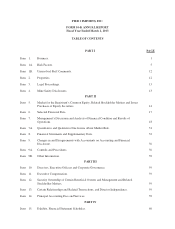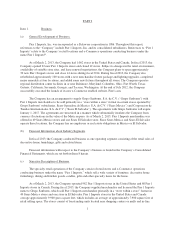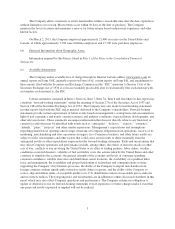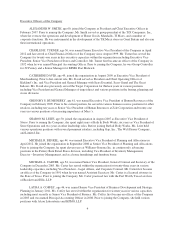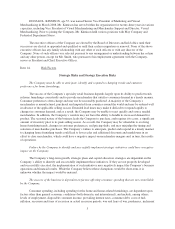Pier 1 2013 Annual Report Download - page 15
Download and view the complete annual report
Please find page 15 of the 2013 Pier 1 annual report below. You can navigate through the pages in the report by either clicking on the pages listed below, or by using the keyword search tool below to find specific information within the annual report.failures could negatively affect any of the Company’s retail locations, distribution centers, administrative
facilities, ports, or locations of its suppliers domestically and in foreign countries.
Risks Associated with Dependence on Technology
The Company is heavily dependent on various kinds of technology in the operation of its business.
Failure of any critical software applications, technology infrastructure, telecommunications, data
communications, data storage equipment, or networks could have a negative effect, including additional expense,
on the Company’s ability to manage the merchandise supply chain, sell merchandise, accomplish payment
functions, report financial data or manage labor and staffing. Although the Company maintains off-site data
backups, a concentration of technology-related risk exists in the Company’s headquarters located in Fort Worth,
Texas.
Failure to protect the integrity and security of individually identifiable data of the Company’s customers
and employees could expose the Company to litigation and damage the Company’s reputation.
The Company receives and maintains certain personal information about its customers, vendors and
employees. The collection and use of this information by the Company is regulated at the international, federal
and state levels, and is subject to certain contractual restrictions in third party contracts. Although the Company
has implemented processes to collect and protect the integrity and security of personal information, there can be
no assurance that this information will not be obtained by unauthorized persons, or collected or used
inappropriately. If the security and information systems of the Company or of its internal or external business
associates are compromised or its internal or external business associates fail to comply with these laws and
regulations and this information is obtained by unauthorized persons, or collected or used inappropriately, it
could negatively affect the Company’s reputation, as well as operations and financial results, and could result in
litigation against the Company or the imposition of penalties. As privacy and information security laws and
regulations change, the Company may incur additional costs to remain in compliance.
Failure to successfully implement new information technology systems and enhance existing systems
could negatively impact the business and its financial results.
As part of the Company’s growth plan, the Company is investing in new information technology systems
and implementing modifications and upgrades to existing systems. These investments include replacing legacy
systems, making changes to existing systems, building redundancies, and acquiring new systems and hardware
with updated functionality. The Company is taking appropriate actions to ensure the successful implementation
of these initiatives, including the testing of new systems and the transfer of existing data, with minimal
disruptions to the business. However, there can be no assurance the Company has anticipated all potential risks
and failure to successfully implement these initiatives could negatively impact the business and its financial
results.
The expansion of the Company’s e-Commerce business has inherent cybersecurity risks that may disrupt
its business.
The Company’s full e-Commerce functionality in the United States has increased the Company’s
exposure to cybersecurity risks. A compromise of its security systems could result in a service disruption, or
customers’ personal information or the Company’s proprietary information being obtained by unauthorized
users. Although the Company has implemented processes to mitigate the risks of security breaches and cyber
incidents, there can be no assurance that such an attack will not occur. Any breach of the Company’s security
could result in violation of privacy laws, potential litigation, and a loss of confidence in its security measures, all
of which could have a negative impact on the Company’s financial results and its reputation.
9



